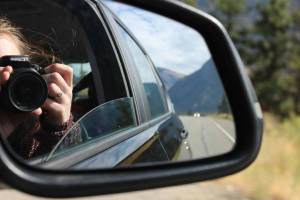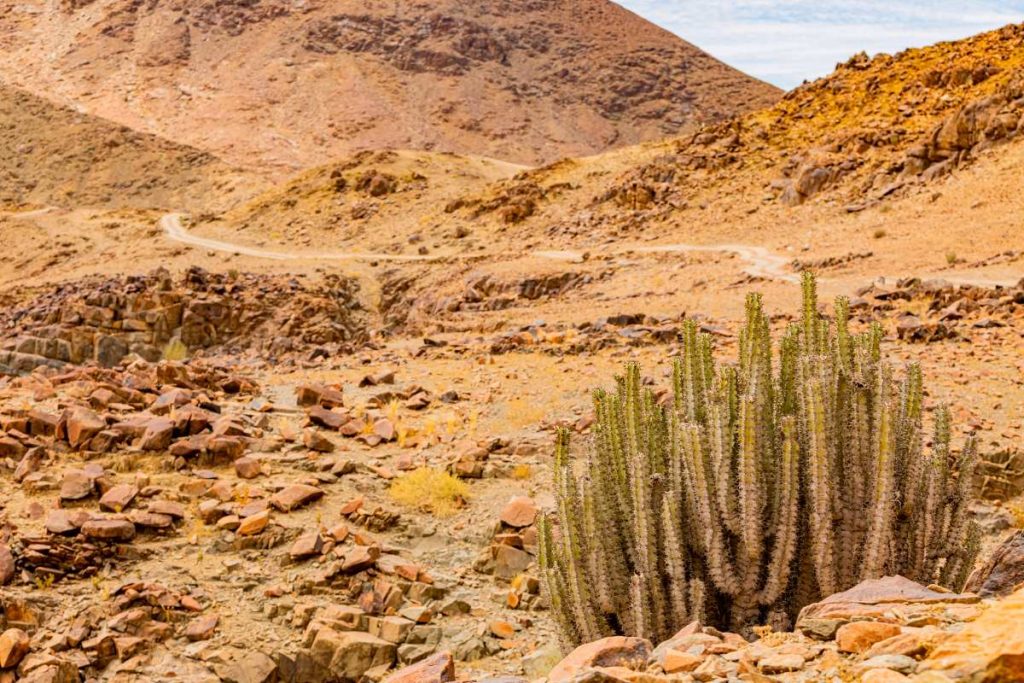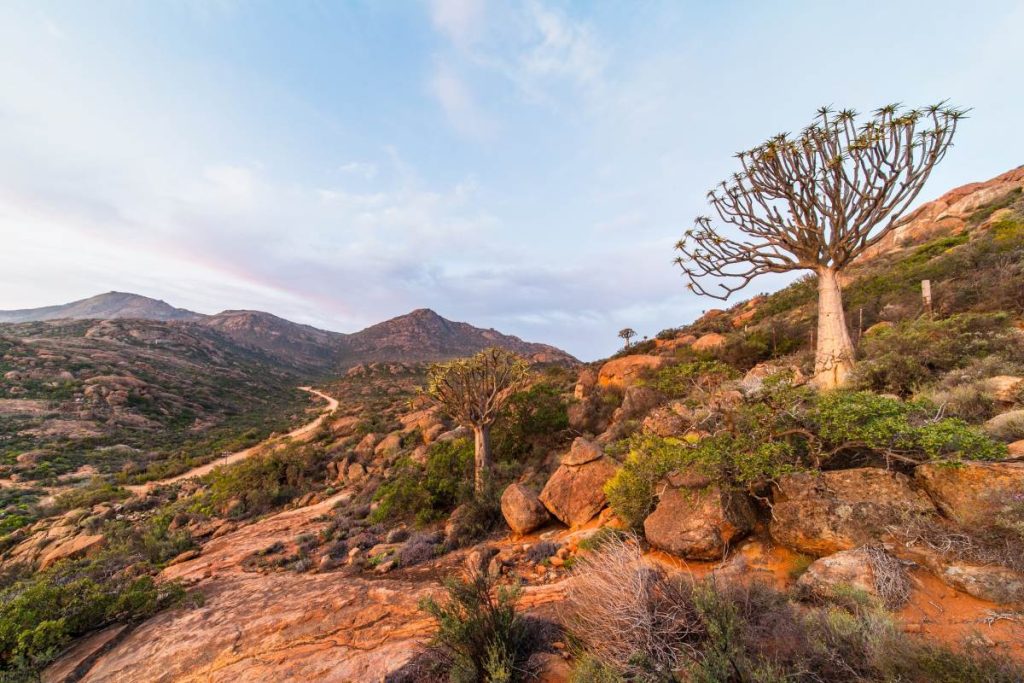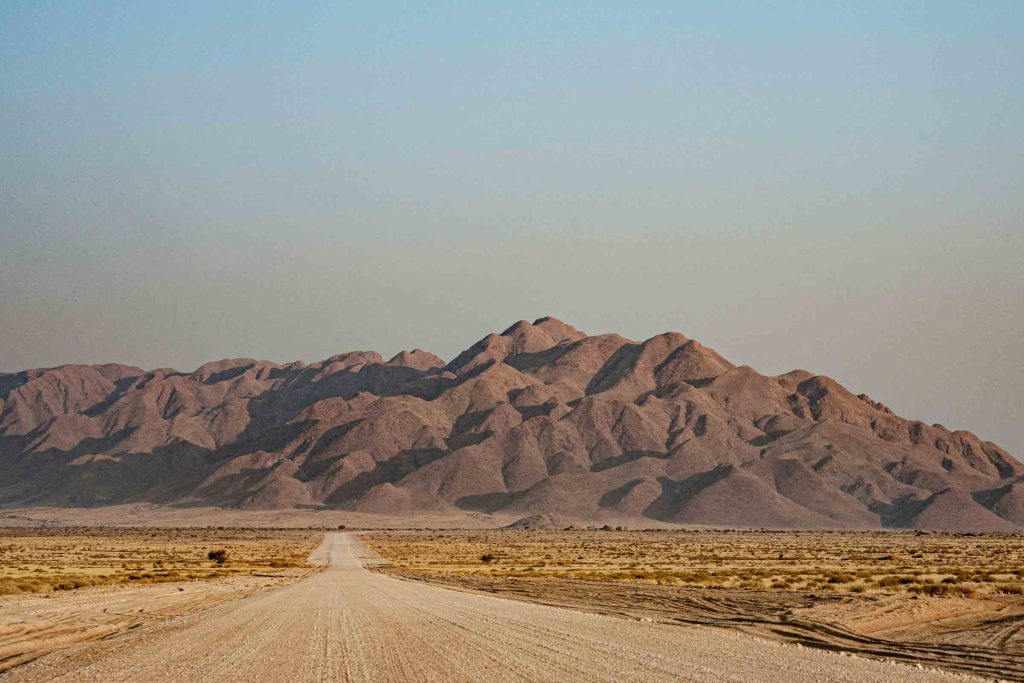
5 Road Trips to Enjoy Over Easter Weekend 2025
Easter Weekend is one of South Africa’s most popular times for adventurous getaways, with local...
 14 April 2025
14 April 2025 
From Namaqualand to the Richtersveld, South Africa’s Northern Cape is arguably the country’s most underrated province. And, if you find yourself behind the wheel of a 4×4, you can explore the most remote and untouched corners of the region.
Whether you’re chasing the wildflower blossoms of the West Coast or the desert-adapted wildlife of the Kalahari, you’re in for an incredible adventure. We’ve put together a list of the top 4×4 trails in the province – take your pick and get going on your self-drive 4×4 expedition.

Photo: Getty
The Namakwa Eco Trail offers an all-encompassing 4×4 experience in the Northern Cape between Pella and Alexander Bay. It winds along the beating heart of the region: the Orange River. This multi-day, approximately 600 km trail showcases the rugged beauty of the Namaqualand region, including its expansive landscapes, jagged, rocky terrain, and seasonal wildflower displays.
Each stage of the trail introduces varied driving conditions, from rocky mountain passes to sandy riverbeds, with opportunities to spot local wildlife and take in stunning vistas. The route is mostly self-guided, allowing for a flexible pace, with designated camping spots along the way that provide a sense of remoteness and connection to nature. In fact, some of these campsites lie along the Orange River, meaning you can cool off in the murky waters.
In addition to the natural beauty, the Namakwa Eco Trail offers insights into the region’s rich history, geology, and flora, making it a rewarding journey for those keen on learning about the area’s scientific significance.
The Richtersveld is one of South Africa’s lesser-known UNESCO World Heritage Sites. Here, Nama pastoralists still follow the same seasonal migration patterns they’ve been using for at least two millennia. In that time, their unique land management processes have helped protect the area’s unique succulent Karoo vegetation. These herders still construct portable huts called haru om and maintain a strong tradition of oral history.
The Richtersveld might be a desert, but it’s home to over 4,800 plant species, including the iconic quiver tree and “halfmensboom”. Furthermore, 40% of them are endemic, and the greater Succulent Karoo ecoregion boasts around a third of all the world’s succulent plant species. It’s no wonder many regard it as the only arid biodiversity hotspot on the planet.
The rocky, sandy landscape is ideal for off-roading, especially along the gravel trails of the ǀAi-ǀAis/Richtersveld Transfrontier Park. You can even camp along the Orange River and cross over into Namibia on a cable ferry! Just make sure you pack enough water for your trip – the Richtersveld sees barely any rain.

Photo: Getty
Namaqua National Park, located in the heart of Namaqualand in the Northern Cape, is world-renowned for its extraordinary wildflower season. Every year, after winter rains, the typically dry landscape bursts into a vibrant display of colour, with fields of daisies, vygies, and other wildflowers carpeting the plains. Even outside the flower season, the park’s unique biodiversity and striking desert scenery make it a captivating destination for nature lovers.
The park is home to more than 3,500 plant species, many of which are endemic to the region, including succulents and the famous quiver tree. Wildlife such as springbok, klipspringer, and a variety of bird species can be seen year-round, while the park’s rocky hills, sandy plains, and coastal dunes offer a range of environments to explore.
The absolute best way to experience the park is the Caracal Eco Route, which includes the inland Skilpad Wildflower Reserve and 50km of sandy tracks along the coast. This stretch includes several coastal campsites, each equipped with little more than a few eco toilets and some firepits.
The Kgalagadi Transfrontier Park, located in the heart of the Kalahari Desert, offers a unique wilderness experience shared between South Africa and Botswana. This vast semi-arid park is home to the indigenous San people, who have adapted to the harsh desert environment over thousands of years, using traditional knowledge and seasonal migration patterns to sustain their way of life.
Though the Kgalagadi might seem barren, it supports a surprising diversity of wildlife. Over 200 bird species, including raptors like the martial eagle, thrive here, alongside iconic desert animals such as gemsbok, meerkats, and the famed black-maned Kalahari lions. The park’s expansive red dunes and dry riverbeds create an otherworldly landscape that makes for surreal wildlife viewing and off-road adventures.
Off-road enthusiasts can explore the park’s 4×4 trails that traverse the sandy terrain, with opportunities to camp at remote wilderness campsites along the way. The vastness of the Kgalagadi provides a sense of isolation and tranquillity, making it a top destination for those seeking both adventure and solitude.
Augrabies Falls National Park, located in the Northern Cape along the Orange River, is a rugged desert landscape best known for the impressive Augrabies Falls, where the river plunges 56 m into a granite gorge. The park is named after the Khoe word Aukoerebis, meaning “Place of Great Noise,” a fitting description for the thundering cascade, especially during flood season.
Despite its arid surroundings, Augrabies Falls National Park is home to a surprising range of flora and fauna. Succulent plants, quiver trees, and hardy acacias thrive in the harsh conditions, while wildlife such as klipspringers, black eagles, and dassies can often be spotted among the rocky outcrops. The park is also home to giraffes, springbok, and other desert-adapted species.
For off-road enthusiasts, Augrabies offers a 30 km long self-guided 4×4 trail that winds through the park’s rocky and sandy terrain, offering breathtaking views of the falls and surrounding landscape. Keep in mind that you’ll need to partner up with another 4×4 if you want to take it on.
Riemvasmaak, nestled in the Northern Cape near the Namibian border, offers a remote and rugged adventure destination set against the dramatic backdrop of towering cliffs and rocky desert landscapes. The area has a rich and complex history, with indigenous people having reclaimed the land after being displaced during apartheid.
The area is well-known for its natural hot springs, which lie at the bottom of a steep gorge surrounded by striking rock formations. Visitors can enjoy a relaxing soak while taking in the stunning views. Beyond the hot springs, Riemvasmaak offers excellent opportunities for hiking, mountain biking, and 4×4 trails that cut through the rocky terrain.
Riemvasmaak’s desert environment is also home to various plant species, including hardy succulents and the distinctive quiver tree. Wildlife such as klipspringers, vervet monkeys, and numerous bird species can also be spotted in the area.
Tankwa Karoo National Park, located on the border of the Northern and Western Cape, is a remote and starkly beautiful destination, known for its vast, open plains and rugged mountain ranges. This semi-desert landscape is characterised by its dramatic silence, wide horizons, and unique biodiversity, offering visitors an escape into one of South Africa’s most untouched wilderness areas.
Despite the arid conditions, Tankwa Karoo is home to an array of desert-adapted flora and fauna. Succulents and low-lying shrubs dominate the landscape, with the spring months bringing a surprising burst of wildflowers. The park also supports a range of wildlife, including gemsbok, Cape mountain zebra, and bat-eared foxes, as well as over 180 bird species, making it a favourite spot for birdwatching enthusiasts.
For those looking for adventure, Tankwa Karoo’s rugged terrain is ideal for 4×4 trails, which lead through rocky passes and expansive plains, offering breathtaking views of the surrounding mountains. The park also has several remote campsites, allowing visitors to fully immerse themselves in the tranquillity and isolation of the Karoo. With very limited facilities and no shops, visitors should come fully prepared with water, food, and fuel, as the extreme heat and lack of shade can make the desert conditions challenging.
Goegap Nature Reserve, located near Springbok in the Northern Cape, is a striking example of Namaqualand’s rugged beauty. Known for its stunning spring wildflower displays, particularly after good rains, the reserve transforms into a vibrant sea of colour with daisies, lilies, and other endemic species covering the arid landscape. Outside of the flower season, Goegap’s rocky hills, sandy plains, and unique desert flora still offer plenty for nature lovers to explore.
The reserve is home to over 600 indigenous plant species, including the iconic quiver tree and various succulents that thrive in the harsh environment. Wildlife sightings include gemsbok, springbok, and Hartmann’s mountain zebra, along with numerous bird species. Goegap is a sanctuary for those looking to experience the serene beauty of the Northern Cape’s desert environment.
For off-road enthusiasts, Goegap Nature Reserve offers several 4×4 trails that wind through the reserve’s rocky terrain, providing an opportunity to explore its remote corners. Visitors can also enjoy hiking trails and picnic spots, while the star-filled night skies make it an ideal destination for stargazing.

Photo: Unsplash
The Northern Cape offers some of the most challenging and breathtaking 4×4 routes in South Africa. From the rugged beauty of the Richtersveld to the stunning wildflowers of the Namakwa Eco Trail, there is something for drivers of all skill levels. When you’re ready to head off-road, browse through our comprehensive selection of 4×4 vehicles, including camping-equipped models.